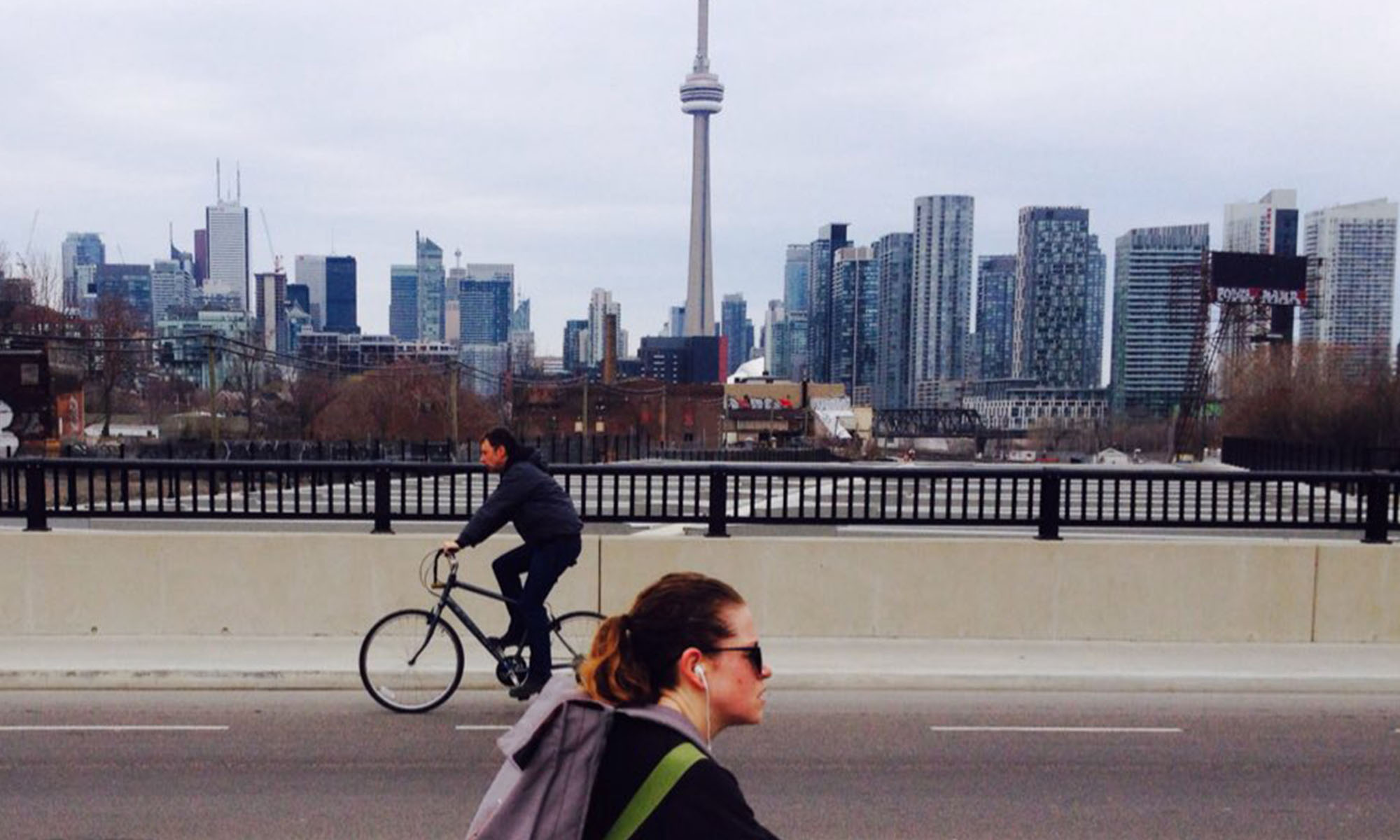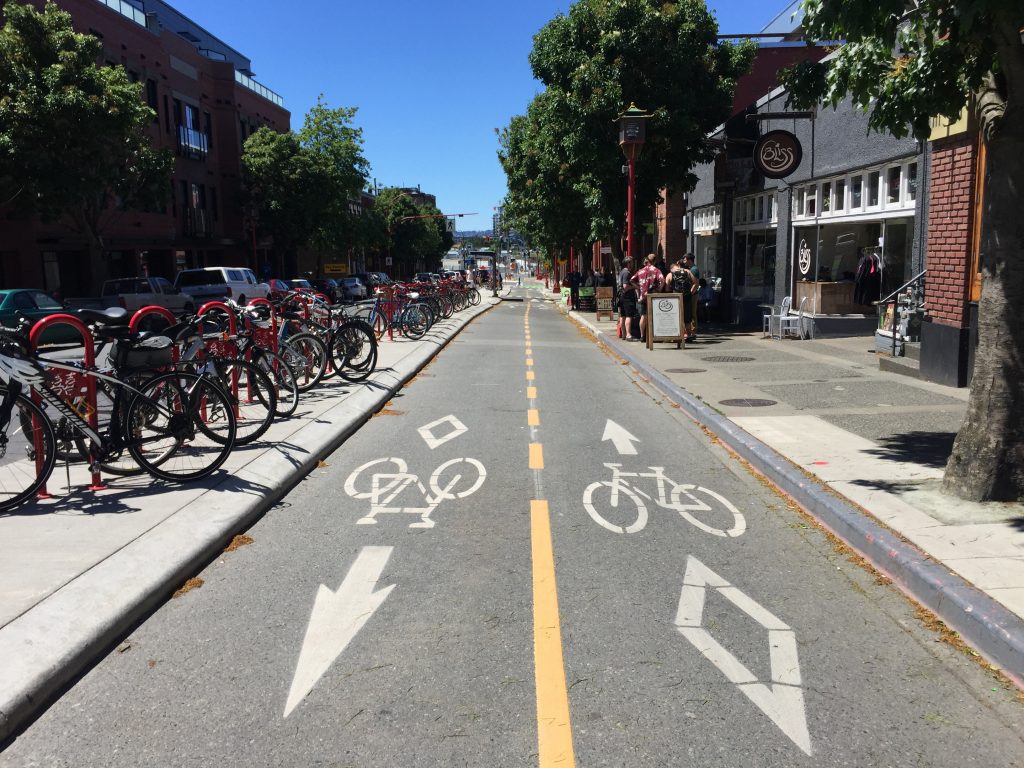Summary
When a country isn’t bike friendly, women are the first to be left behind. Cycling presents a unique opportunity to address a range of economic and practical disadvantages acutely felt by women in society. There is, therefore, an urgent need to make cycling more practical and accessible in Canada – especially for women and girls.
Transportation is currently the top barrier to education and employment for women. Women are more likely to run errands before/after work. Overall, their travel patterns vary considerably from those of men. As a result, they struggle to integrate within transportation systems planned by men which focus on rush hour trips. Conflicting schedule pattens mean that women are disproportionately affected by seemingly minor details experienced by men: this includes lack of public transport availability at off peak hours and a lack of provision of infrastructure in both suburban and urban areas for modes of travel that require frequent short trips. Men are more likely to drive straight to a single destination while women tend to make more trips with brief stops where additional time lost to parking is relatively inconvenient. The economic and time pressure felt by women is compounded by the fact that women tend to make less money per hour while they are working. Women and girls are also less likely to meet the recommended amounts of physical activity than men and boys due to lower levels of participation in organized sports and other factors, making the moderate physical activity that would arise from the everyday physical activity of cycling disproportionately important for both personal and public health reasons.
All of these factors combine to increase the practicality, desirability and impact of a cost effective and efficient independent transportation solution ideal for medium range distances (1-7km) with little to no operating costs or wasted time from parking. Such functionality is uniquely embodied by bicycles and cargo bikes alone.
This likely explains why, in countries with similar climates that have created the circumstances conducive to safe, convenient and comfortable everyday practical cycling, cycling rates for women are many times higher then we find here, to the point where women outnumber men. In Canada, even though a bicycle would be particularly advantageous for them, women tend not to ride – especially in dense urban neighbourhoods where it would be most practical and where it would offer the most potential to achieve overarching government priorities such as greenhouse gas emission abatement and poverty reduction through increased accessibility.
The solution is almost certainly the provision of safe and comfortable infrastructure.
Women’s perceptions of cycling have additional effects on other demographics since women act as major influencers on those around them. For example, women’s current perception of cycling in general is almost certainly devaluing the bicycle tourism industry in Canada, since women are overwhelmingly the arbiter of a family’s tourism spending and make key travel habit choices during leisure times. The ingrained perceptions of women are also likely having an effect on the intergenerational transmission of transportation habits since women tend to spend more time with younger children and have more influence on large household purchasing decisions (such as automobiles or a housing). Other factors, such as a lack of representation in culture and in the bicycle industry are ancillary compounding factors to be addressed.
VCB calls upon the Government of Canada to invest in cycling to promote gender equity. One way to do this is to support our call for a National Cycling Strategy and dedicated infrastructure funds to support cycling.
Government of Canada sources:
“Wage gap continues – women earn about 80% of men’s full-time, full year wages.”
( Status of Women Canada 2015–16 Departmental Performance Report – Source )
“On transportation, Canadian households spent an average of $11,909 in 2016, almost the same as 2015. The largest portion ($10,660) went toward private transportation, which includes spending on the purchase of cars, trucks and vans, as well as their operating costs.” ( Survey of Household Spending, 2016 – Source )
“Males were more likely than females to have cycled in the past year (46% versus 34%), regardless of age, income or education. Males residing in population centres were more likely than those in rural areas to cycle; the opposite was true for females, who were more likely than males to report excessive traffic as a barrier to cycling.” (Cycling in Canada – Statistics Canada – Source )
“ Older senior women are most likely to be limited in their day-to-day travel, either because they are passengers who have no driver’s licence “ ( Profile of Seniors’ Transportation Habits – Statistics Canada – Source )
“A higher percentage of women drove to schools and daycares and retail establishments as their next stop after leaving home during morning rush hour” ( Trip chaining while driving—comparing men’s and women’s behaviour – Statistics Canada – Source )
“A lack of transportation options can be a barrier to the full economic participation of women. Access to public transit systems plays an important role in supporting women’s ability to access the workforce, as well as supporting services and resources, such as health services and childcare. . . . transportation is the number one barrier to … accessing educational opportunities, and accessing employment.” In urban settings, the cost of public transit and the lack of suitable schedules are barriers to the economic participation of women. In northern, rural and remote communities, there is often an absence of public transit which can be a problem for women who may not be able to afford a car.
“
( Report of the Standing Committee on the Status of Women Women’s Economic Security: Securing The Future Of Canada’s Economy – FEWO – Source )
“
Recommendation 13
That the Government of Canada expand the eligibility requirements of the Public Transit Infrastructure Fund to include not-for-profit and non‑governmental community transit organizations, where municipally funded transportation services are not available.
“
( Report of the Standing Committee on the Status of Women Women’s Economic Security: Securing The Future Of Canada’s Economy – FEWO – Source )
“
Recommendation 14
That the Government of Canada, immediately and on an ongoing basis, increase investment in public transportation that will ensure affordable, accessible, frequent and safe transit services for women.
”
( Report of the Standing Committee on the Status of Women Women’s Economic Security: Securing The Future Of Canada’s Economy – FEWO – Source )
“A public bicycle system is a bank of bicycles that can be picked up and dropped off at numerous points across an urban area. The bicycles are available to the general public for short‐term use for free or for a small fee.” ( Bike Sharing Guide – Transport Canada – Source )
“Our MIssion: To serve the public interest through the promotion of a safe and secure, efficient and environmentally responsible transportation system in Canada.
Our Vision: A transportation system in Canada that is recognized worldwide as safe and secure, efficient and environmentally responsible.
Our Raison d’être, Mandate and Role: Who we are and what we do: At Transport Canada, we are responsible for developing and overseeing the Government of Canada’s transportation policies and programs so that Canadians can have access to a transportation system that is:
- Safe and secure;
- Green and innovative; and
- Efficient”
( Mission, Vision and Mandate – Transport Canada – Source)
“In 2013, the proportion of people who met the Canadian Physical Activity Guidelines differs by age and sex.” (Health Status of Canadians 2016: Report of the Chief Public Health Officer – What is influencing our health? – Physical activity – Source)
_______
Velo Canada Bikes Documents:
“A particular opportunity for improving mobility exists for Canadian women, who are considerably less likely to ride bicycles than Canadian men. According to North American experts, a major explanatory factor is a lack of safe conditions.” (2018 Pre-Budget Submission – Source)
“The powerful and wide-ranging benefits of cycling relate to numerous critical areas that are clear priorities for
the Government of Canada. These include climate change and the need for low carbon transportation, health,
gender and social equity, reconciliation with Indigenous peoples, tourism and small business.” ( VCB Position Paper – Source )
“It ensures that everyone, regardless of their age, ability, gender, economic status or postal code is able to personally enjoy the innumerable benefits of cycling.”
( National Cycling Strategy Overview – Source)
__________
Canadian Media sources
“Only one in 3 cyclists in the Greater Toronto Area and Hamilton are female. It’s a statistic that’s in keeping with other North American cities.,,the report found that more than half of the trips women take every day could potentially be cycled.” (Why poor infrastructure keeps women from cycling – CBC Source)
“German, Danish and Dutch women cycle as often as men but the numbers are much different in North America. In Canada, just 29 per cent of daily bike commuters were women, according to 2006 census data, although that number did rise in Canadian cities: women made up 35 per cent of bicycle commuters in Toronto and Montreal and 37 per cent in Vancouver. ( Is there a gender gap among commuting cyclists? The numbers are stark – Globe and Mail Source )
“Women’s safety and biking are more interconnected than some might think. The “cycling gender gap”—the idea that women make up a disproportionately low fraction of bikers and that the reasons for this underrepresentation have to do with safety and greater gender inequality—is not a new concept. Though there’s little hard research for Toronto on the subject, we know that the gap is established at an early age: research last year found that high school girls in Toronto had “less access to a bicycle, less comfort or confidence in riding, [and] more fear associated with cycling.”” (Why Bike Safety is Still an Issue for Women in Toronto – The Torontoist – Source )
“If the consumer economy had a sex, it would be female. Women drive 70-80% of all consumer purchasing, through a combination of their buying power and influence. Influence means that even when a woman isn’t paying for something herself, she is often the influence or veto vote behind someone else’s purchase.” (Forbes – Source)
Canadian Academic sources:
“The results showed a pattern of hesitancy to cycle on the part of female high school students compared with their male counterparts.” (Cycling to High School in Toronto, Ontario, Canada: Exploration of School Travel Patterns and Attitudes by Gender Source )
“A consistent pattern of gender differences and women’s lower participation in utility cycling is evident. This is primarily attributed to the risks (actual and perceived) associated with cycling in countries with relatively poor cycling infrastructure, policies, regulations and low cycling prevalence” (Integrated strategies to accelerate the adoption of cycling for transportation – Science Direct Source )
“Our results indicate that female students cycled less compared to male students for both commute (6.8% versus 10.3%) and non-commute (7.9% versus 11.6%) purposes.” (Does the Built Environment Explain Gender Gap in Cycling? a Study of Post-Secondary Students in Toronto, Canada – MoveTO Source )
“Women and transit pass holders were less likely, while students rather than staff were more likely to cycle during the winter.” ( Facilitators and Barriers to Winter Cycling: Case Study of a Downtown University in Toronto, Canada – Ryerson Source )
“…90 per cent of travel decision-makers are female. “Their perspectives help define the leisure travel industry,” said Dorothy Dowling, Best Western’s senior vice president of Marketing and Sales.”
(Top travel habits of Canadian and U.S. women revealed – Global News Source)
International Academic sources
“With traditionally men working in transport sector, it is therefore not surprising that transport policies have generally favoured car use over public transport, cycling and walking. Decisions regarding transport policy are generally taken by “mature” men, precisely the age group that mainly travels by car.” (Gender and Transport – OECD International Transport Forum Discussion Paper – Source)
“The issue of taking account of gender in transport is a fairly recent one. Since the statistics do not differentiate between men and women, it is hard to understand the differences in reasons for making trips, trip frequency, distances travelled, mobility-related problems in gaining access to health services, employment, etc” (Gender and Transport – OECD International Transport Forum Discussion Paper – Source)
“Women frequently need to make trips outside rush hours and to destinations different to those of men, for example to go shopping or to accompany children to school, health centres, etc. The time lost in travelling is therefore far more penalising for women.“ (Gender and Transport – OECD International Transport Forum Discussion Paper – Source)
In both North America and Europe, for example, women make more trips, and in chains that are more complex, than those made by men, notably due to the fact that they undertake more non work-related trips. At the same time, their journey-to-work trips are shorter as their area of access to jobs is often smaller due to time constraints and their lesser degree of access to a private car. Because of the complexity of their travel chains and the fact that they have more trips to make, they are more dependent on the car. However, when they have the time, they make greater use of public transport and walking than men for equivalent trips. (Gender and Transport – OECD International Transport Forum Discussion Paper – Source)
“The difficulties faced by women with regard to their mobility are a form of social exclusion which affects all aspects of their lives and in particular hinders the economic output and health of women.” (Gender and Transport – OECD International Transport Forum Discussion Paper – Source)
“If women wish to find work and combine a professional life with housework, they must overcome innumerable obstacles and in particular: non-proximity between the place of residence, workplace and shops; insufficient public transport, particularly in suburbs and outside rush hours; public transport schedules aimed primarily at journey-to-work trips;” (Gender and Transport – OECD International Transport Forum Discussion Paper – Source)
“As in other areas, in order to evaluate the issue of gender in relation to transport and mobility issues, it must first be possible to measure it. The World Bank has identified four fields in which statistics on the interactions between gender and transport would be useful to planners: 1) access to different modes of transport, 2) the cost of transport, 3) trip characteristics (modes, frequency, length of trips, reasons for trips), and 4) transport quality.” (Gender and Transport – OECD International Transport Forum Discussion Paper – Source)
“For women, having choices that will provide easier and fairer conditions of access to all the possibilities afforded by cities is an essential issue. Being able to put an end to confinement and/or isolation is a major step towards the personal fulfilment of women.” (Gender and Transport – OECD International Transport Forum Discussion Paper – Source)
“ In low-cycling countries, cycling is not evenly distributed across genders and age groups. . . . n high-cycling countries, where gender differences exist, women tend to cycle more than men.” ( Does More Cycling Mean More Diversity in Cycling? Source )
“In this large, population-based, prospective study, we found that women who reported regular exercise, cycling for transportation, or a higher level of nonexercise activity were at a 20–50 percent lower risk for early mortality compared with the less active women.” (Influence of Exercise, Walking, Cycling, and Overall Nonexercise Physical Activity on Mortality in Chinese Women – Source )
“In this sample of 1862 bicyclists, men were more likely than women to cycle for recreation and for transport, and they cycled for longer. Most transport cycling was for commuting, with men more likely than women to commute by bicycle. Men were more likely to cycle on-road, and women off-road. However, most men and women did not prefer to cycle on-road without designed bicycle lanes, and qualitative data indicated a strong preference by men and women for bicycle-only off-road paths…. The main constraints for both genders and both cycling purposes were perceived environmental factors related to traffic conditions, motorist aggression and safety. Women, however, reported more constraints, and were more likely to report as constraints other environmental factors and personal factors.” (Gender differences in recreational and transport cycling: a cross-sectional mixed-methods comparison of cycling patterns, motivators, and constraints – Source
“Gender differences were statistically significant for preferring bicycle signals (63.7% men, 69.1% women) and cycle tracks (53.9% men, 60.2% women). “ ( Gender and used/preferred differences of bicycle routes, parking, intersection signals, and bicycle type: Professional middle class preferences in Hangzhou, China – Source )
International Media sources
“The main reason most women don’t cycle in the UK is because they think it is dangerous.”
( Women shun cycling because of safety, not helmet hair – Guardian – Source )
“Among all households with kids and one breadwinner, women tend to commute 13 minutes less than men do, and the largest gender difference for work travel occurs in households with children and two breadwinners: 16 minutes.” (Women Still Do More Traveling Than Men for Household Errands – CityLab – Source)
“there is widespread support for greater investment in cycling, with as many as four in five women supporting better funding for cycling” (Study reveals the stark gender gap in cycling and what could be done to close it. – Cycling Weekly UK Source)
“If there aren’t at least as many women as men, then usually it’s because cycling is not safe enough. It’s an indicator that you do not have good enough cycling infrastructure.” (‘If there aren’t as many women cycling as men … you need better infrastructure’ – Guardian Source)
“[In the US} Women account for 85% of overall consumer spending including everything from autos to healthcare … [including] 92% Vacations . . . 91% of New Homes . . . 65% New Cars (FAST FACTS Marketing to Women – Source)
Prepared by Anders Swanson, Dea van Lierop, and Sara Kirk
Velo Canada Bikes 2018



